小学生英语口语课件
- 格式:ppt
- 大小:693.50 KB
- 文档页数:42
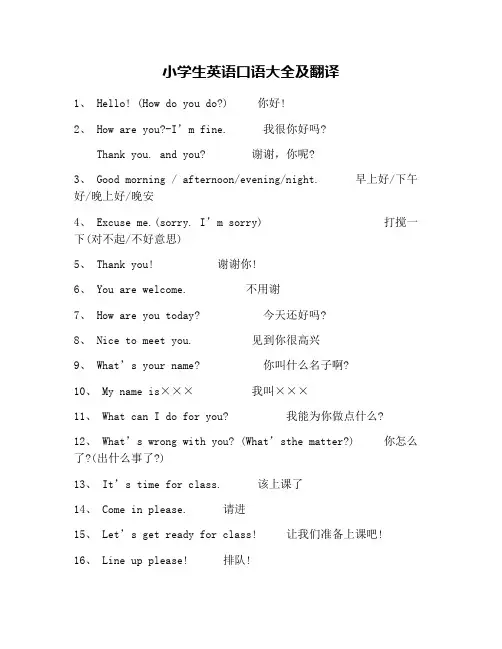
小学生英语口语大全及翻译1、 Hello! (How do you do?) 你好!2、 How are you?-I’m fine. 我很你好吗?Thank you. and you? 谢谢,你呢?3、 Good morning / afternoon/evening/night. 早上好/下午好/晚上好/晚安4、Excuse me.(sorry. I’m sorry) 打搅一下(对不起/不好意思)5、 Thank you! 谢谢你!6、 You are welcome. 不用谢7、 How are you today? 今天还好吗?8、 Nice to meet you. 见到你很高兴9、What’s your name? 你叫什么名子啊?10、My name is×××我叫×××11、 What can I do for you? 我能为你做点什么?12、What’s wrong with you? (What’sthe matter?)你怎么了?(出什么事了?)13、It’s time for class. 该上课了14、 Come in please. 请进15、Let’s get ready for class!让我们准备上课吧!16、 Line up please! 排队!17、 Attention please! 立正!18、 At ease. 稍息19、 Turn life/right! 向左/右转!20、 One bye one please.no pushing. 一个一个来,不要挤【篇二】1、 What are you going to do tonight? 今晚干啥去?2、I’m going to Disney’s English Club. 我要去迪士尼英语俱乐部3、I’m going to learn Disney’s Magic English. 我去学迪士尼神奇英语4、What’s on tonight? 今晚有什么节目?5、Let’s watch TV. 我们看电视吧!6、We are going to the Pople’s Prk. 我们要去人民公园7、 Be quiet.please. 请安静8、Stop talking!(Do’t talk.) 别讲话9、Don’t worry about it. 不要为这担心10、 No problem. 没问题11、 Clap your hands. 鼓撑拍手12、 Class is over.(Time is up.) 下课了!(时间到了)13、 See you next time.Bye bye! 下次见,再见14、 Well done! 干得好!15、 You are so smart! 你真聪明!16、 How clever you are! 你真是太聪明了!17、Let’s have a rest.(take a break) 我们休息一下18、 It’s time to go to bed. 该睡觉了19、It’s time to get up.(Wake up.please.) 该起床了(醒醒)20、 Wash your face/hands/foot. 洗脸/手/脚【篇三】1、 Comb your hair. 梳头2、 Brush your teeth. 刷牙3、Come on.Let’s play together. 过来,我们一起玩4、Let’s play a game. 我们来玩个游戏。
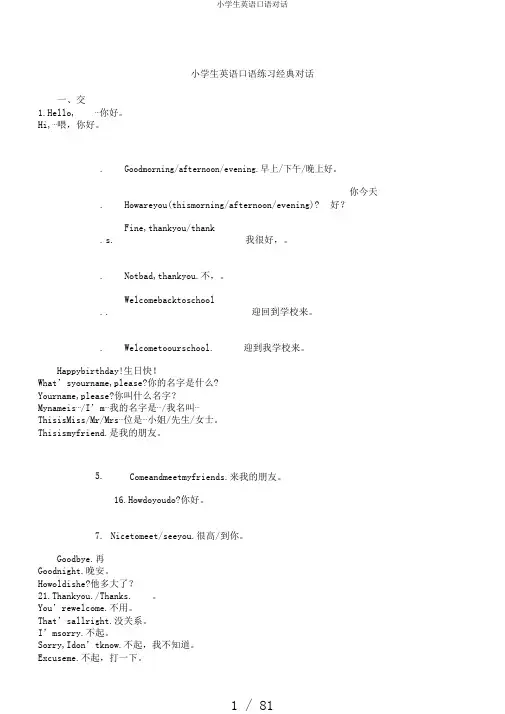
小学生英语口语练习经典对话一、交1.Hello, ⋯你好。
Hi,⋯喂,你好。
3.Goodmorning/afternoon/evening.早上/下午/晚上好。
4.Howareyou(thismorning/afternoon/evening)?你今天好?5 .Fine,thankyou/thanks.我很好,。
6.Notbad,thankyou.不,。
7 .Welcomebacktoschool.迎回到学校来。
8.Welcometoourschool.迎到我学校来。
Happybirthday!生日快!What’syourname,please?你的名字是什么?Yourname,please?你叫什么名字?Mynameis⋯/I’m⋯我的名字是⋯/我名叫⋯ThisisMiss/Mr/Mrs⋯位是⋯小姐/先生/女士。
Thisismyfriend.是我的朋友。
1eandmeetmyfriends.来我的朋友。
16.Howdoyoudo?你好。
17.Nicetomeet/seeyou.很高/到你。
Goodbye.再Goodnight.晚安。
Howoldishe?他多大了?21.Thankyou./Thanks. 。
You’rewelcome.不用。
That’sallright.没关系。
I’msorry.不起。
Sorry,Idon’tknow.不起,我不知道。
Excuseme.不起,打一下。
2ein,please.。
28.Havesomebananas,please.吃些香蕉。
It’stimeforthecakes.吃些蛋糕了。
MayIcomein?我可以来?MayIhaveyours?我能吃你的?CanIhavetwocakes?我能吃两个蛋糕?No,youcan’t.不,你不能。
CanIhaveone,please?我能吃一个?36.Yes./Allright.Hereyouare. 好的。
你。
CanIgowithyou?我能和你一起走?Sure.好的。
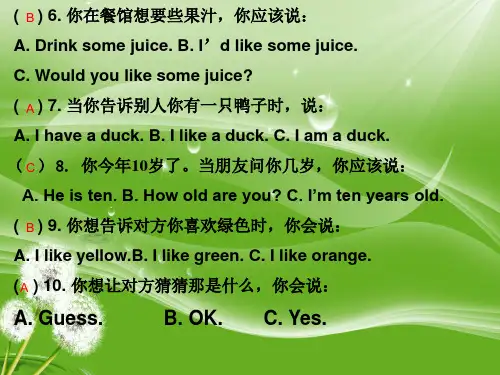

小学生英语口语对话小学生英语口语对话公司内部档案编码:[OPPTR-OPPT28-OPPTL98-OPPNN08]小学生英语口语练习经典对话一、交际1. Hello, …你好。
2. Hi, …喂,你好。
3. Good morning/ afternoon/evening. 早上/下午/晚上好。
4. How are you(this morning/afternoon/evening) 你今天好吗5. Fine, thank you/ thanks. 我很好,谢谢。
6. Not bad, thank you. 不错,谢谢。
7. Welcome back to school. 欢迎回到学校来。
8. Welcome to our school. 欢迎到我们学校来。
9. Happy birthday! 生日快乐!10. What’s your name, please 你的名字是什么11. Your name, please 你叫什么名字12. My name is…/ I’m…我的名字是…/ 我名叫…13. This is Miss/ Mr/ Mrs…这位是…小姐/先生/女士。
14. This is my friend. 这是我的朋友。
15. Come and meet my friends. 过来见见我的朋友们。
16. How do you do 你好。
17. Nice to meet /see you. 很高兴认识/见到你。
18. Goodbye. 再见19. Good night. 晚安。
20. How old is he 他多大了21. Thank you./ Thanks. 谢谢。
22. You’re welcome. 不用谢。
23. That’s all right. 没关系。
24. I’m sorry. 对不起。
25. Sorry, I don’t know. 对不起,我不知道。
26. Excuse me. 对不起,打扰一下。
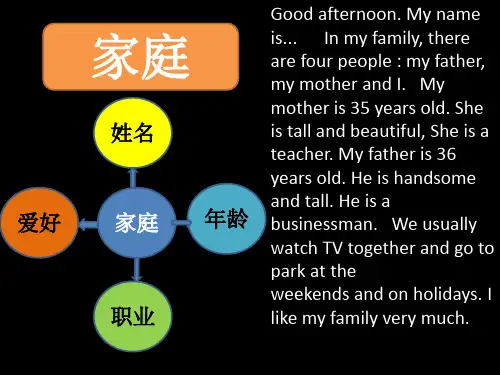

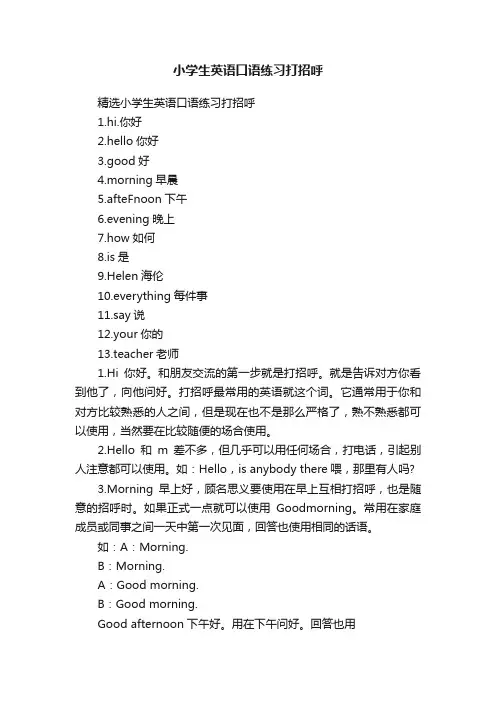
小学生英语口语练习打招呼精选小学生英语口语练习打招呼1.hi.你好2.hello你好3.good好4.morning早晨5.afteFnoon下午6.evening晚上7.how如何8.is是9.Helen海伦10.everything每件事11.say说12.your你的13.teacher老师1.Hi你好。
和朋友交流的第一步就是打招呼。
就是告诉对方你看到他了,向他问好。
打招呼最常用的英语就这个词。
它通常用于你和对方比较熟悉的人之间,但是现在也不是那么严格了,熟不熟悉都可以使用,当然要在比较随便的场合使用。
2.Hello和m差不多,但几乎可以用任何场合,打电话,引起别人注意都可以使用。
如:Hello,is anybody there喂,那里有人吗?3.Morning早上好,顾名思义要使用在早上互相打招呼,也是随意的招呼时。
如果正式一点就可以使用Goodmorning。
常用在家庭成员或同事之间一天中第一次见面,回答也使用相同的话语。
如:A:Morning.B:Morning.A:Good morning.B:Good morning.Good afternoon下午好。
用在下午问好。
回答也用Good afternoon.Good evening.晚上好。
用于晚上问好。
回答也用Good evening.这几个招呼的.回答都用同一个词,对方怎样和你招呼,你就和对方怎样招呼:对方说m,你就说Hi;对方说Hello,就说Hello;对方说Morning,你就说morning;对方说good morning你就说good morning.不会错的。
4.How are you你好。
也非常口语化,常常用在I{i,Heuo之后。
如:Oh,hi,Mary!How are you?噢,玛丽,你好。
How are you的回应更常见的是用Fine,或I'm fine.通常还要紧接一句感谢,thank you.How is Helen.海伦好吗?是向第三方问候,回答当然也要用第三方打头:She is well.5.How do you do?你好。
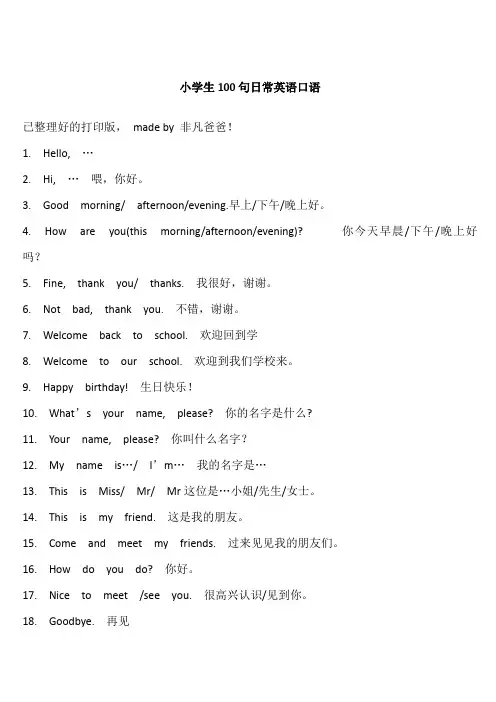
小学生100句日常英语口语已整理好的打印版,made by 非凡爸爸!1.Hello,…2.Hi,…喂,你好。
3.Good morning/afternoon/evening.早上/下午/晚上好。
4.How are you(this morning/afternoon/evening)?你今天早晨/下午/晚上好吗?5.Fine,thank you/thanks.我很好,谢谢。
6.Not bad,thank you.不错,谢谢。
7.Welcome back to school.欢迎回到学8.Welcome to our school.欢迎到我们学校来。
9.Happy birthday!生日快乐!10.What’s your name,please?你的名字是什么?11.Your name,please?你叫什么名字?12.My name is…/I’m…我的名字是…13.This is Miss/Mr/Mr这位是…小姐/先生/女士。
14.This is my friend.这是我的朋友。
e and meet my friends.过来见见我的朋友们。
16.How do you do?你好。
17.Nice to meet/see you.很高兴认识/见到你。
18.Goodbye.再见19.Good night.晚安。
20.How old is he?他多大了?21.Thank you./Thanks.谢谢。
22.You’re welcome.不用谢。
23.That’s all right.没关系。
24.I’m sorry.对不起25.Sorry,I don’t know.对不起,我不知道。
26.Excuse me.对不起,打扰一下。
e in,please.请进。
28.Have some bananas,please.请吃些香蕉。
29.It’s time for the cakes.该吃些蛋糕了。
30.May I come in?我可以进来吗?e in,please.请进。
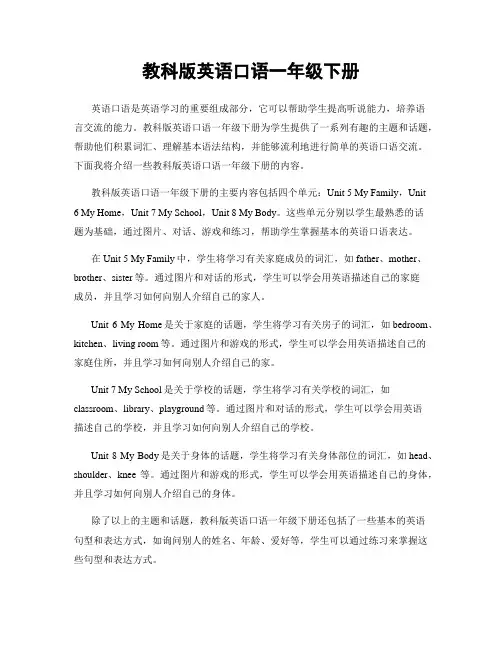
教科版英语口语一年级下册英语口语是英语学习的重要组成部分,它可以帮助学生提高听说能力,培养语言交流的能力。
教科版英语口语一年级下册为学生提供了一系列有趣的主题和话题,帮助他们积累词汇、理解基本语法结构,并能够流利地进行简单的英语口语交流。
下面我将介绍一些教科版英语口语一年级下册的内容。
教科版英语口语一年级下册的主要内容包括四个单元:Unit 5 My Family,Unit 6 My Home,Unit 7 My School,Unit 8 My Body。
这些单元分别以学生最熟悉的话题为基础,通过图片、对话、游戏和练习,帮助学生掌握基本的英语口语表达。
在Unit 5 My Family中,学生将学习有关家庭成员的词汇,如father、mother、brother、sister等。
通过图片和对话的形式,学生可以学会用英语描述自己的家庭成员,并且学习如何向别人介绍自己的家人。
Unit 6 My Home是关于家庭的话题,学生将学习有关房子的词汇,如bedroom、kitchen、living room等。
通过图片和游戏的形式,学生可以学会用英语描述自己的家庭住所,并且学习如何向别人介绍自己的家。
Unit 7 My School是关于学校的话题,学生将学习有关学校的词汇,如classroom、library、playground等。
通过图片和对话的形式,学生可以学会用英语描述自己的学校,并且学习如何向别人介绍自己的学校。
Unit 8 My Body是关于身体的话题,学生将学习有关身体部位的词汇,如head、shoulder、knee等。
通过图片和游戏的形式,学生可以学会用英语描述自己的身体,并且学习如何向别人介绍自己的身体。
除了以上的主题和话题,教科版英语口语一年级下册还包括了一些基本的英语句型和表达方式,如询问别人的姓名、年龄、爱好等,学生可以通过练习来掌握这些句型和表达方式。
教科版英语口语一年级下册的教学目标是培养学生的英语口语交际能力,让学生能够用英语进行简单的日常交流。
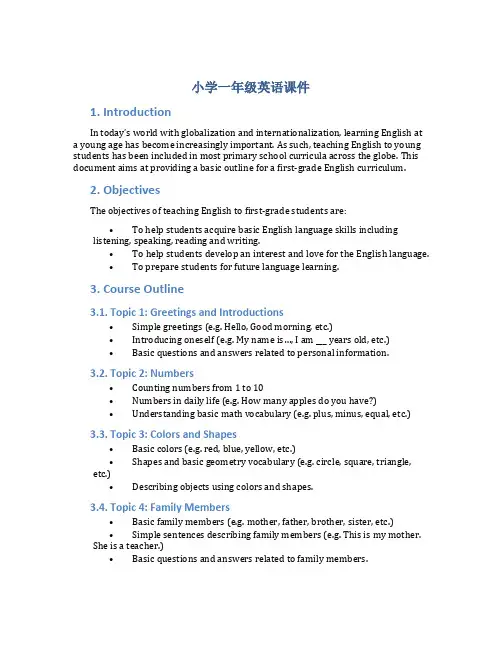
小学一年级英语课件1. IntroductionIn today’s world with globalization and internationalization, learning English at a young age has become increasingly important. As such, teaching English to young students has been included in most primary school curricula across the globe. This document aims at providing a basic outline for a first-grade English curriculum.2. ObjectivesThe objectives of teaching English to first-grade students are:•To help students acquire basic English language skills including listening, speaking, reading and writing.•To help students develop an interest and love for the English language.•To prepare students for future language learning.3. Course Outline3.1. Topic 1: Greetings and Introductions•Simple greetings (e.g. Hello, Good morning, etc.)•Introducing oneself (e.g. My name is…, I am ___ years old, etc.)•Basic questions and answers related to personal information.3.2. Topic 2: Numbers•Counting numbers from 1 to 10•Numbers in daily life (e.g. How many apples do you have?)•Understanding basic math vocabulary (e.g. plus, minus, equal, etc.)3.3. Topic 3: Colors and Shapes•Basic colors (e.g. red, blue, yellow, etc.)•Shapes and basic geometry vocabulary (e.g. circle, square, triangle, etc.)•Describing objects using colors and shapes.3.4. Topic 4: Family Members•Basic family members (e.g. mother, father, brother, sister, etc.)•Simple sentences describing family members (e.g. This is my mother.She is a teacher.)•Basic questions and answers related to family members.3.5. Topic 5: Action verbs•Basic action verbs (e.g. run, walk, jump, etc.)•Simple sentences using action verbs (e.g. I can run fast, She can jump high, etc.)•Describing daily activities using action verbs.3.6. Topic 6: Food and Drinks•Basic food and drink vocabulary (e.g. apple, banana, milk, etc.)•Simple sentences related to food and drinks (e.g. I like apples, She drinks milk for breakfast, etc.)•Basic questions and answers related to food and drinks.4. Teaching MethodologyTeaching English to young children requires a lot of patience, creativity and a variety of teaching methodologies. Keeping this in mind, the following methodologies may be used:•Songs and rhymes•Picture books and flashcards•Games and activities•Role plays and puppet shows•Audio-visual aids5. AssessmentAssessing young English learners requires a different kind of approach. Some of the methods that can be used include:•Observing students during class activities•Listening to students’ speaking and pronunciation skills•Looking through students’ written work and vocabulary retention•Conducting weekly or monthly quizzes and tests6. ConclusionTeaching English to first-grade students requires a lot of effort and dedication, but it can also be an enjoyable experience. With the curriculum and methodologies mentioned above, teachers can create an engaging and fun-filled learning environment for students. As students begin to acquire basic English language skills, they will also develop a lifelong interest in the language and an eagerness to learn more.。